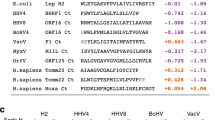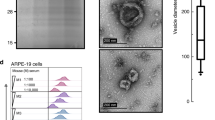Abstract
We found that chronic lymphocytic leukemic (CLL) B cells are highly sensitive to infection with vectors derived from replication-defective herpes simplex virus-1 (rdHSV-1). CLL B cells were found to express high levels of herpes virus entry mediator (Hve) A, but not HveC, the other known receptor for HSV-1. An HveA cDNA from CLL cells was found to encode Arg→Lys and Val→Iso substitutions at amino acids 17 and 241, respectively. Nevertheless, this cDNA encoded a functional receptor for HSV-1 when transfected into Chinese hamster ovarian (CHO) cells. Antibodies to HveA could block rdHSV-1 infection of CLL cells and HveA-transfected CHO cells with similar efficiencies in vitro. In contrast to B cells of normal donors, CLL B cells were resistant to the cytopathic effects of infection by rdHSV-1 and maintained high-level expression of the transgene for several days in vitro. We propose that this is due to the expression by CLL cells of the anti-apoptotic protein, bcl-2. Consistent with this, we found that transduction of HeLa cells with a retrovirus expression vector encoding bcl-2 rendered HeLa cells resistant to the cytopathic effects of rdHSV-1. HSV-1-derived vectors should be excellent vehicles for gene transfer into CLL B cells, allowing for its potential use in gene therapy for this disease.
This is a preview of subscription content, access via your institution
Access options
Subscribe to this journal
Receive 12 print issues and online access
$259.00 per year
only $21.58 per issue
Buy this article
- Purchase on Springer Link
- Instant access to full article PDF
Prices may be subject to local taxes which are calculated during checkout







Similar content being viewed by others
References
Kipps TJ . Chronic lymphocytic leukemia and related diseases. In: Beutler E, Lichtman M, Coller B, Kipps TJ (eds) Williams Hematology, edn 5 McGraw-Hill: New York 1995 1017–1039
Kipps TJ . Chronic lymphocytic leukemia Curr Opin Hematol 1997 4: 268–276
Cantwell MJ et al. Adenovirus vector infection of chroniclymphocytic leukemia B cells Blood 1996 88: 4676–4683
Kato K et al. Gene transfer of CD40-ligand induces autologous immune recognition of chronic lymphocytic leukemia B cells J Clin Invest 1998 101: 1133–1141
Herold BC et al. Glycoprotein C-independent binding of herpes simplex virus to cells requires cell surface heparan sulphate and glycoprotein B J Gen Virol 1994 75: 1211–1222
Tufaro F . Virus entry: two receptors are better than one Trends Microbiol 1997 5: 257–258; discussion 258–259
Spear PG et al. Heparan sulfate glycosaminoglycans as primary cell surface receptors for herpes simplex virus Adv Exp Med Biol 1992 313: 341–353
Eberlé F et al. The human PRR2 gene, related to the human poliovirus receptor gene (PVR), is the true homolog of the murine MPH gene Gene 1995 159: 267–272
Geraghty RJ et al. Entry of alphaherpesviruses mediated by poliovirus receptor-related protein 1 and poliovirus receptor Science 1998 280: 1618–1620
Krummenacher C et al. Herpes simplex virus glycoprotein D can bind to poliovirus receptor-related protein 1 or herpesvirus entry mediator, two structurally unrelated mediators of virus entry J Virol 1998 72: 7064–7074
Warner MS et al. A cell surface protein with herpesvirus entry activity (HveB) confers susceptibility to infection by mutants of herpes simplex virus type 1, herpes simplex virus type 2, and pseudorabies virus Virology 1998 246: 179–189
Lopez M et al. Complementary DNA characterization and chromosomal localization of a human gene related to the poliovirus receptor-encoding gene Gene 1995 155: 261–265
Montgomery RI et al. Herpes simplex virus-1 entry into cells mediated by a novel member of the TNF/NGF receptor family Cell 1996 87: 427–436
Kwon BS et al. A newly identified member of the tumor necrosis factor receptor superfamily with a wide tissue distribution and involvement in lymphocyte activation J Biol Chem 1997 272: 14272–14276
Hsu H et al. ATAR, a novel tumor necrosis factor receptor family member, signals through TRAF2 and TRAF5 J Biol Chem 1997 272: 13471–13474
Whitbeck JC et al. Glycoprotein D of herpes simplex virus (HSV) binds directly to HVEM, a member of the tumor necrosis factor receptor superfamily and a mediator of HSV entry J Virol 1997 71: 6083–6093
Johnson PA et al. Cytotoxicity of a replication-defective mutant of herpes simplex virus type 1 J Virol 1992 66: 2952–2965
Paterson T, Everett RD . A prominent serine-rich region in Vmw175, the major transcriptional regulator protein of herpes simplex virus type 1, is not essential for virus growth in tissue culture J Gen Virol 1990 71: 1775–1783
Hanada M et al. Bcl-2 gene hypomethylation and high-level expression in B-cell chronic lymphocytic leukemia Blood 1993 82: 1820–1828
Molica S et al. Comparative flow cytometric evaluation of bcl-2 oncoprotein in CD5+ and CD5− B-cell lymphoid chronic leukemias Haematologica 1997 82: 555–559
Molica S et al. Increased bcl-2/bax ratio in B-cell chronic lymphocytic leukemia is associated with a progressive pattern of disease Haematologica 1998 83: 1122–1124
Dilloo D et al. A novel herpes vector for the high-efficiency transduction of normal and malignant human hematopoietic cells Blood 1997 89: 119–127
Cocchi F et al. The V3 domain of the HIV-1 gp120 envelopeglycoprotein is critical for chemokine-mediated blockade ofinfection Nature Med 1996 2: 1244–1247
Cocchi F et al. The ectodomain of a novel member of the immunoglobulin subfamily related to the poliovirus receptor has the attributes of a bona fide receptor for herpes simplex virus types 1 and 2 in human cells J Virol 1998 72: 9992–10002
Marsters SA et al. Herpesvirus entry mediator, a member of the tumor necrosis factor receptor (TNFR) family, interacts with members of the TNFR-associated factor family and activates the transcription factors NF-kappaB and AP-1 J Biol Chem 1997 272: 14029–14032
Higgins JP, Warnke RA . Herpes lymphadenitis in association with chronic lymphocytic leukemia Cancer 1999 86: 1210–1215
Pezzella F et al. Expression of the bcl-2 oncogene protein is not specific for the 14;18 chromosomal translocation Am J Pathol 1990 137: 225–232
Schena M et al. Growth- and differentiation-associated expression of bcl-2 in B-chronic lymphocytic leukemia cells Blood 1992 79: 2981–2989
Wang MJ, Friedmann T, Johnson PA . Differentiation of PC12 cells by infection with an HSV-1 vector expressing nerve growth factor Gene Therapy 1995 2: 323–335
Yee JK, Friedmann T, Burns JC . Generation of high-titer pseudotyped retroviral vectors with very broad host range Methods Cell Biol 1994 43: 99–112
Johnson PA et al. Cytotoxicity of a replication-defective mutant of herpes simplex virus type 1 J Virol 1992 66: 2952–2965
DeLuca NA, Schaffer PA . Activities of herpes simplex virus type 1 (HSV-1) ICP4 genes specifying nonsense peptides Nucleic Acids Res 1987 15: 4491–4511
Rassenti LZ, Kipps TJ . Lack of allelic exclusion in B cell chronic lymphocytic leukemia J Exp Med 1997 185: 1435–1445
Chen CA, Okayama H . Calcium phosphate-mediated gene transfer: a highly efficient transfection system for stably transforming cells with plasmid DNA Biotechniques 1988 6: 632–638
Fiering SN et al. Improved FACS-Gal: flow cytometric analysis and sorting of viable eukaryotic cells expressing reporter gene constructs Cytometry 1991 12: 291–301
Acknowledgements
We greatly appreciate the anti-HveA polyreactive antibody provided to us by Patricia Spear. We also acknowledge Bill Wierda, Jan Burger, Astrid Sandoval and Patricia Diotto for their technical and writing assistance. This work was supported in part by National Institutes of Health grants R01CA66000–05 and R37CA49870–12.
Author information
Authors and Affiliations
Rights and permissions
About this article
Cite this article
Eling, D., Johnson, P., Sharma, S. et al. Chronic lymphocytic leukemia B cells are highly sensitive to infection by herpes simplex virus-1 via herpesvirus-entry-mediator A. Gene Ther 7, 1210–1216 (2000). https://doi.org/10.1038/sj.gt.3301241
Received:
Accepted:
Published:
Issue Date:
DOI: https://doi.org/10.1038/sj.gt.3301241
Keywords
This article is cited by
-
Herpes simplex virus 1 induces egress channels through marginalized host chromatin
Scientific Reports (2016)
-
Suppressor of cytokine signaling-1 expression by infectivity-enhanced adenoviral vector inhibits IL-6-dependent proliferation of multiple myeloma cells
Cancer Gene Therapy (2006)
-
Herpes simplex virus type-1 amplicon vectors for vaccine generation in acute lymphoblastic leukemia
Gene Therapy (2005)



